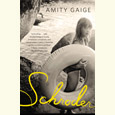A Living Being
Poet Richard Tillinghast has written a lively, insightful guide to the ancient city of Istanbul
Istanbul has become a trendy destination for American tourists in recent years, but poet Richard Tillinghast began visiting decades ago, when he was editor of the Let’s Go travel guide in the early 1960s. A Memphis native who has been a dedicated wanderer for most of his life, Tillinghast has come to know Istanbul well over time, learning its history, culture, and language in the process. An Armchair Traveller’s History of Istanbul: City of Forgetting and Remembering, part of Haus Publishing’s Armchair Traveller collection, is a smart and engaging guide to this ancient metropolis. By combining a lively survey of Istanbul’s past with an insider’s tour of the city today, Tillinghast has created a fascinating book for travelers and homebodies alike.
 True to its title, the book’s primary focus is the history of Istanbul, often called the Queen of Cities. “A city is a living being, with a memory of its own,” Tillinghast writes. “The more we know of what Istanbul remembers, and even what it tries to forget, the more we enter into its essence.” In thirty-two short chapters, Tillinghast manages to explore much of the enormous breadth of Istanbul’s memory, from its founding as Constantinople in 324 to the twentieth-century rise of the modern Republic of Turkey, when the city became officially known by its long-held Turkish name.
True to its title, the book’s primary focus is the history of Istanbul, often called the Queen of Cities. “A city is a living being, with a memory of its own,” Tillinghast writes. “The more we know of what Istanbul remembers, and even what it tries to forget, the more we enter into its essence.” In thirty-two short chapters, Tillinghast manages to explore much of the enormous breadth of Istanbul’s memory, from its founding as Constantinople in 324 to the twentieth-century rise of the modern Republic of Turkey, when the city became officially known by its long-held Turkish name.
Condensing such a broad survey into so few pages could make for tiresome reading, but Tillinghast keeps his narrative concise and witty. This is history rich with anecdotes and occasionally lurid details. For example, he quotes Gibbon on the Emperor Constantine’s fondness for elaborate wigs and jewelry, and he includes a sixth-century account of the early years of the Empress Theodora which describes her as “a harlot, of the kind that our ancestors used to call ‘the infantry.’” Readers will learn more than they may want to know about how palace eunuchs were acquired. But there is serious, thoughtful history throughout the book, as well, particularly in the chapter on the early years of the Republic, when Istanbul took on a more modern, secular character under the nationalist reformer Atatürk.
Tillinghast’s vivid accounts of the past provide the foundation for his guide to the Istanbul of today. He takes the reader along on visits to the city’s classic attractions—Haghia Sophia, Topkapi Palace, etc.—and gives a history of each, as well as tips on little-known features and ways to steer clear of the tourist hordes. He explores the city’s neighborhoods and gives much attention to favorite spots for eating and drinking. In fact, there’s an entire chapter devoted to the “Turkish kitchen,” with enthusiastic descriptions of everything from kavun (a type of melon) to mumbar (sheep’s intestine stuffed with bulgur).
Tillinghast writes with insight and sensitivity about Istanbul’s heterogeneous religious cultures. Some of the best sections in An Armchair Traveller’s History of Istanbul are devoted to discussions of Byzantine and Islamic art and the way each was shaped by theological concerns. There’s a fascinating chapter about his visit to a meeting of dervishes, the Sufi mystics known for their ecstatic chanting and dancing. Elsewhere he ponders his own emotional response, as a “rebel and a freethinker,” to the Muslim call to prayer.
Not surprisingly for a poet, Tillinghast is also attentive to how language has shaped the city. He spends a few pages elaborating on the quirks and nuances of Turkish, and the book includes a rather eclectic glossary, wherein alem (the copper crescent on top of a minaret) shares the page with am (“a vulgar word for vagina”).
There’s a staggering amount of information packed into this little book, but it reads easily, thanks to Tillinghast’s elegant writing. His portrait of present-day Istanbul is carefully nestled within an overall structure that follows a straight historical timeline, so there’s never a feeling that facts and dates are being thrown out willy-nilly. And since, as Tillinghast notes, it “would be a tall order” to keep track of the scores of emperors and sultans who have controlled the city, the book includes a short chronology of significant events and a complete list of rulers, from Constantine to current Turkish President Abdullah Gül. There is also a nineteen-page historical gazetteer that refers readers back to relevant passages in the text.
Good travel writing offers, beyond solid reportage, some sense of an actual journey. It provides the brisk pleasure of encountering unfamiliar and extraordinary things. With the very best travel writing, there’s the added pleasure of feeling that the writer is sharing his particular vision of a place, that the raw impressions have been filtered through a unique sensibility. The wealth of historical information in An Armchair Traveller’s History of Istanbul is conveyed in Tillinghast’s engaging voice and vision. It feels like a collection of fascinating, rich stories of the city, delivered by a brilliant friend.


